设计模式—— 七大设计原则
Posted 玛丽莲茼蒿
tags:
篇首语:本文由小常识网(cha138.com)小编为大家整理,主要介绍了设计模式—— 七大设计原则相关的知识,希望对你有一定的参考价值。
设计模式都是遵循以下7个原则去设计的:
- 单一职责原则
- 接口隔离原则
- 依赖倒置原则(面向接口编程原则)
- 里式替换原则
- 开闭原则
- 迪米特法则
- 合成复用原则
一、单一职责原则
定义:在类的级别上,一个类只负责一项职责;在方法的级别上,一个方法只做一件事。
二、接口隔离原则
定义:一个类对另一个类的依赖应该建立在最小接口上。
举个违反接口隔离原则的例子:
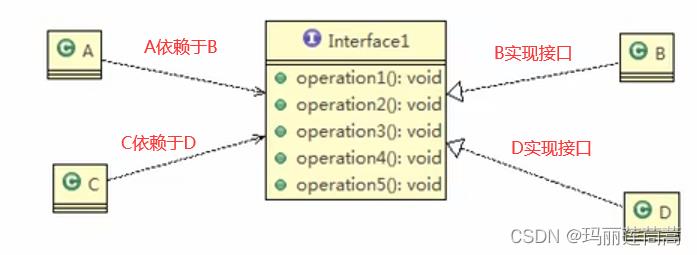
类A通过接口Interface1依赖类B,类C通过接口Interface1依赖类D(看了代码就明白了)。
package HeadFirst;
/**
* 【违反】接口隔离原则的例子
*/
public class InterfaceIsolationTest
public static void main(String[] args)
//
B b = new B();
A a = new A();
a.test1(b);
a.test2(b);
a.test3(b);
//
D d = new D();
C c = new C();
c.test1(d);
c.test4(d);
c.test5(d);
interface Interface1
void operation1();
void operation2();
void operation3();
void operation4();
void operation5();
//类B实现接口Interface1
class B implements Interface1
public void operation1()
System.out.println("B 实现operation1");
public void operation2()
System.out.println("B 实现operation2");
public void operation3()
System.out.println("B 实现operation3");
public void operation4()
System.out.println("B 实现operation4");
public void operation5()
System.out.println("B 实现operation5");
//类D实现接口Interface1
class D implements Interface1
public void operation1()
System.out.println("D 实现operation1");
public void operation2()
System.out.println("D 实现operation2");
public void operation3()
System.out.println("D 实现operation3");
public void operation4()
System.out.println("D 实现operation4");
public void operation5()
System.out.println("D 实现operation5");
//类A 通过接口依赖类B
class A
public void dependB1(Interface1 i)
i.operation1(); //B的operation1
public void dependB2(Interface1 i)
i.operation2();//B的operation2
public void dependB3(Interface1 i)
i.operation3();//B的operation3
//类C 通过接口依赖类D
class C
public void dependD1(Interface1 i)
i.operation1();//D的operation1
public void dependD4(Interface1 i)
i.operation4();//D的operation4
public void dependD5(Interface1 i)
i.operation4();//D的operation5
类A只需要使用类B对接口的1/2/3个实现,但是B却实现了接口全部方法;同样,类C只需要使用类D对接口的1/4/5个实现,但是D也实现了接口的全部方法。对B来说,方法4和5是完全没必要实现的,对D来说方法2和3是完全没必要实现的。
按照【接口隔离】原则,划分出3个【最小接口】:
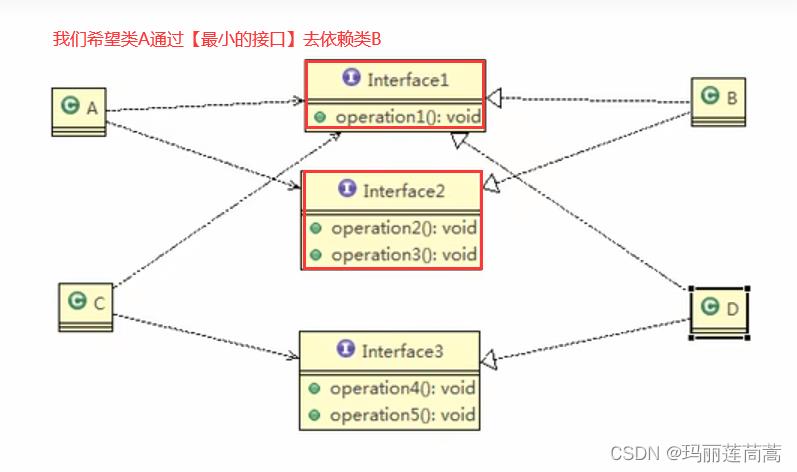
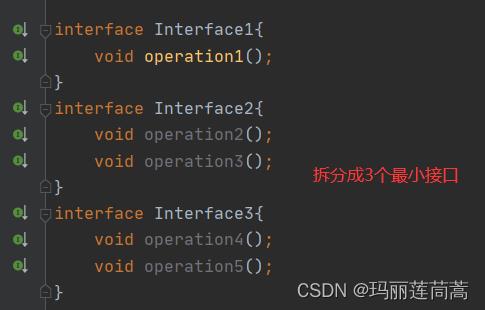

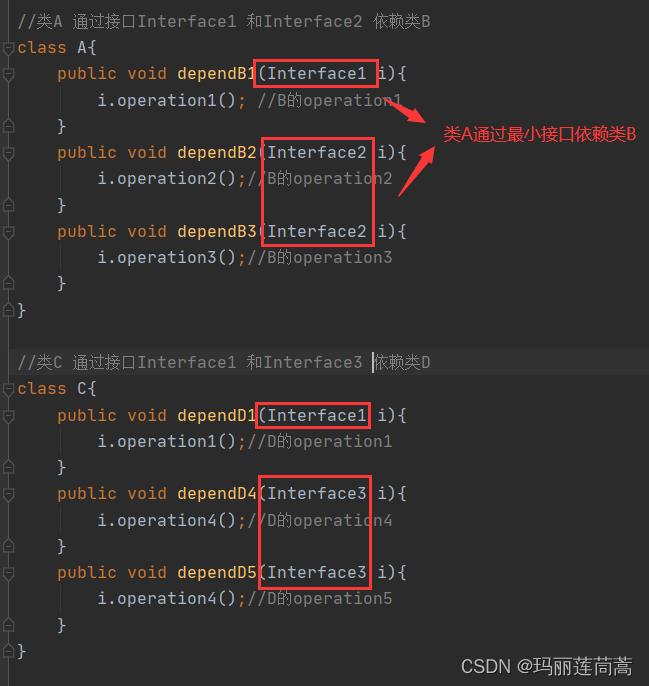
三、依赖倒置原则
定义:
核心思想:面向接口编程,而不是面向具体的实现类编程
3.1 例子
这是之前就体会到也是【最常见】的一种原则 。
什么是依赖?Person类在其方法中使用了另一个类——Email类,就是Person类依赖于Email类。

如果Person类还要接收微信消息、QQ消息,就要对receive方法进行重载。所以面向接口编程就是为了解决大量重载的问题,缩短代码量。
解决:
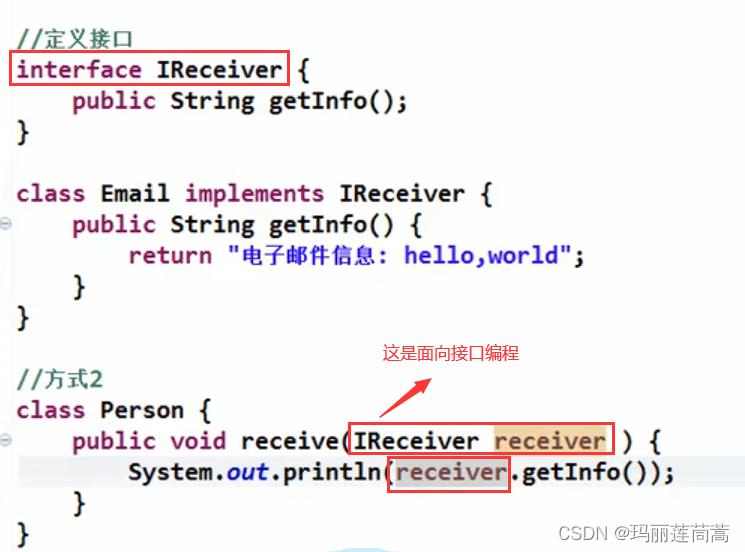
3.2 依赖倒置的三种使用方法/依赖传递的3种方法
还是先弄清被传递的【依赖】是谁?在下面这个例子中,DriverOne类中使用了车的接口ICar,也就是司机依赖于车,所以被传递的依赖是【车】
1. 接口传递
package HeadFirst;
public class Priciple
public static void main(String[] args)
NISSAN nissan = new NISSAN();
DriverOne driver = new DriverOne();
driver.drive(nissan); //通过接口传递依赖
interface ICar
public void run();
interface IDriver
public void drive(ICar car); //接口IDriver 依赖于 接口ICar
class DriverOne implements IDriver
@Override
public void drive(ICar car)
car.run();
class NISSAN implements ICar
@Override
public void run()
System.out.println("尼桑在跑了");
2. 构造方法传递
构造方法传递和setter方法的思路是一样的。直接把依赖的【车】定义为自己的成员变量。
package HeadFirst;
public class Priciple
public static void main(String[] args)
NISSAN nissan = new NISSAN();
DriverOne driver = new DriverOne(nissan);//构造方法传递依赖
driver.drive();
interface ICar
public void run();
interface IDriver
public void drive();
class DriverOne implements IDriver
ICar car; //把依赖的车直接定义为成员变量
DriverOne(ICar car)
this.car = car; //构造方法里传递依赖
@Override
public void drive()
car.run();
class NISSAN implements ICar
@Override
public void run()
System.out.println("尼桑在跑了");
3. setter方法传递
直接把依赖的【车】定义为自己的成员变量,但不在构造方法里传递依赖,而是再写一个专门传递依赖的setter方法。
package HeadFirst;
public class Priciple
public static void main(String[] args)
NISSAN nissan = new NISSAN();
DriverOne driver = new DriverOne();//构造方法传递依赖
driver.setCar(nissan);
driver.drive();
interface ICar
public void run();
interface IDriver
public void drive();
class DriverOne implements IDriver
ICar car; //把依赖的车直接定义为成员变量
@Override
public void drive()
car.run();
public void setCar(ICar car) //setter传递依赖
this.car = car;
class NISSAN implements ICar
@Override
public void run()
System.out.println("尼桑在跑了");
以上是关于设计模式—— 七大设计原则的主要内容,如果未能解决你的问题,请参考以下文章